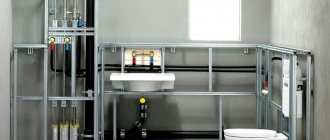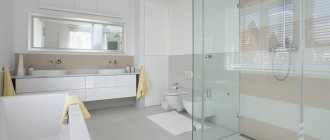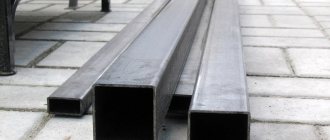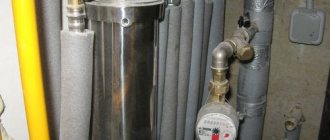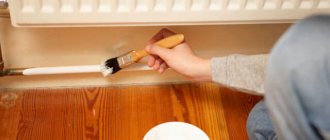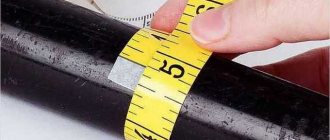The original color of plastic pipelines does not always fit into the interior. To solve this problem, you can assemble a separate frame, but it requires free space. The second option is painting the pipeline elements. This is a simple way to solve the problem, but before you start working, you need to find out what and how to paint polypropylene pipes.
Polypropylene pipes
Painting nuances
Today, modern materials are used in the construction of houses and laying communications: plastic, stainless alloys, non-ferrous metals. And the communications themselves - sewerage and water supply - remain mostly hidden.
Heated towel rails are made of stainless steel or have a galvanic coating. But in old houses there are still pipes made of ferrous metal (cast iron and steel).
They are susceptible to corrosion, do not look aesthetically pleasing and require increased attention, including proper regular painting.
Metal pipes
Before painting, metal pipes need preparation, which consists of washing and removing old paint and rust.
It is recommended to prime metal pipes before painting - the primer will perform protective functions, extend the service life of the pipes and create conditions for good adhesion of the coating to the metal. If the pipes are cold, you need to make sure there is no condensation before applying paint.
If possible, it is better that the pipe is not hot at the time of painting. On a hot surface, paint dries very quickly, and if you are not experienced, it may be difficult to get the perfect result right away.
Galvanized pipes
They do not need to be painted, except for areas where the coating is damaged (threads or welds), such areas must be protected.
Polymer pipes
Plastic pipes do not need protection. Their painting can only be caused by the desire of the owner and interior considerations, since the standard colors of plastic pipes (white or gray, sometimes green or beige) do not always go well with the interior.
It is recommended to treat plastic products with non-aggressive compounds that do not contain acetone. This applies to solvents, primers, and paints. Speaking about the usefulness of a primer for plastic pipes, it should be noted that this is not the most essential element. Properly selected paint fits well on a polymer pipe.
How to level the walls in the bathroom for tiles? Step-by-step instruction.
Read here about the advantages and disadvantages of epoxy grout for bathroom tiles.
Treatment of water pipes
The most affordable way to deal with condensation is to coat cold water pipes with special products. This is required, first of all, for old systems mounted from metal components, since they are most susceptible to corrosion. But it wouldn’t be amiss to treat cold pipelines using more resistant materials that are now used.
Metal pipes
Metal structures are often protected by painting. For these purposes, use oil paint or drying oil. The coloring composition is applied to a previously rust-free and completely dry surface.
It is important to know: while any brand of paint is suitable for cold water pipes, hot water pipes require exclusively heat-resistant materials. Another fairly effective option is to protect the metal with a hardening compound, such as a compound for plugging cracks in walls or floors.
The surface is covered with a layer of paste 5 mm thick, wait until it hardens completely, then sand it using fine-grained sandpaper or sandpaper. After this, you can paint the pipe with oil paint in a color suitable for the interior.
Another fairly effective option is to protect the metal with a hardening compound, such as a crack-clogging compound in walls or floors. The surface is covered with a layer of paste 5 mm thick, wait until it hardens completely, then sand it using fine-grained sandpaper or sandpaper. After this, you can paint the pipe with oil paint in a color suitable for the interior.
Epoxy varnishes and primer compositions can also be used for pipe processing. For better visual perception, suitable paint or enamel is also applied on top of them.
Plastic pipes
Plastic is not subject to corrosion, which makes cold water supply more durable, even if moisture accumulates on the surface. However, accumulated condensation also provokes the appearance of fungus on the walls and puddles on the floor. Therefore, insulating the cold water supply will not harm. Paired foam pads are universal, they just need to be put on the pipe and secured, avoiding any cracks. Mineral wool or glass wool is also used.
Source
Which paint to choose?
For metal pipes, paints and primers based on organic solvents are optimal; water-soluble ones are not suitable.
Today, compositions are offered that combine primer and paint. This makes the job easier. But the traditional method gives more reliable results. The primer provides good adhesion to the metal, the paint adheres well and has a smooth top layer. In addition, such “two-in-one” compositions are presented in a limited range of colors, unlike paints.
The following paints are popular and in demand:
- Alkyd enamel . It is resistant to various influences, including temperature changes. Disadvantage: from the moment of application until complete drying, it emits an unpleasant odor.
- Water-dispersion paint . It has a long service life, dries quickly, has virtually no odor, and is absolutely safe.
- Acrylic enamel . It is durable, aesthetically pleasing, and has good consumer characteristics.
The cost of paint for metal starts from 150 rubles/kg. When painting hot pipes, it is advisable to choose heat-resistant paint.
The following paint options are suitable for painting polymer pipes:
- acrylic and pentaphthalic based on white spirit,
- aqueous compositions for mineral surfaces: dispersed, emulsion, acrylic, organosilicon,
- water-soluble for joinery.
Which plastic pipes can be painted?
Although plastic is a durable, reliable material with excellent heat dissipation, it is very difficult to paint. For example, when installing polyethylene and polypropylene pipes, you must immediately abandon the idea of changing the color. These materials cannot be painted due to their technical properties; even the most tenacious paint will not be able to cover them evenly. Polypropylene pipes can be painted only with preliminary preparation of the material. ABS and PVC plastic can be modified using water-based acrylic paint. But its application also requires preliminary priming and cleaning. Without preparation, the coating will be uneven, with smudges and bald spots. Conditions during dyeing also play an important role. The room temperature should not be lower than 18 degrees, otherwise the paint will crack. Humidity no higher than 80% will have a positive effect on the adhesion of plastic and pigment.
Types of pipes.
Step-by-step instruction
Almost anyone can paint the pipes in the bathroom; it does not require enormous physical effort.
It is necessary to choose the right paint and primer.
If the pipe is metal, then you will need the following set of tools and materials:
- Tools that can be used to clean pipes from old paint and rust (grinder with cleaning disc, metal brush, sharp spatula, sandpaper).
- Rust conversion products.
- Flute brush, roller.
- Cuvette.
- Primer.
- Dye.
- Rags for wiping, materials for protecting floors and walls from accidental paint.
- Gloves.
The procedure is as follows:
- We close the walls and floor around the pipe.
- We clean the pipe from the old coating.
- We treat areas with traces of rust: remove rust with a stiff brush, sand with sandpaper, and treat with a rust converter.
- Carefully wipe the pipe with a damp cloth to remove dust, then wipe it dry.
- Apply primer.
- After the primer has dried, you can paint it. It is better to use a roller, using a brush in hard-to-reach places.
- After the first layer has dried, you can apply the second.
How to remove old grout from tile joints
with your own hands?
Find out in this article how to cover the pipes in the bathroom with plasterboard with your own hands.
By manufacturer
We can give several examples of the most common and high-quality paints for painting heating elements, which are offered to us today by manufacturers from different countries.
For heating pipes you need to use special paint
Radiator Paint is an enamel with a durable white color. It is resistant to temperatures of 90 degrees Celsius, does not emit odor or harmful substances. Millertemp is a metal paint that perfectly prevents corrosion. Available in two color options: charcoal gray or matte aluminum.
It can be applied without a primer, and after drying it can withstand temperatures up to 600 degrees Celsius. Heitzkorperlak is an alkyd enamel that forms a neat surface and can only be applied to cold metal. Elementfarg is another alkyd product that is used without a primer and dries quickly. The maximum permissible temperature is 100 degrees. It can serve as a basis for further painting or act as a finishing layer.
The paint must withstand high temperatures (preferably at least 90–100 degrees). It may contain coloring pigments or special metal powder. The last option is a higher priority.
Painting pipes inside and out or how to paint pipes correctly?
| Wednesday, 16 April 2014 16:45 |
Modern houses have built-in various engineering networks, including sewerage pipes, hot and cold water supply, gas pipelines and other highways. To protect against corrosion and give an aesthetic appearance, their additional processing is often relevant. In this situation, it is easiest to use paint with suitable properties if the pipe is relatively accessible.
Many will say that almost everywhere the water supply is already installed using polypropylene and metal-plastic pipes, but there are still many places where iron pipes are installed. We also must not forget that many of their summer cottages still have irrigation water pipes made of iron pipes, which also need to be renewed by painting every spring. And so, let's talk about everything in order! And we will naturally begin with the stage of preparing pipes for painting.
Hot and cold pipes ↑
Many people are interested in whether there is a difference and how to paint a hot pipe, heating, for example. There are no fundamental differences, but at elevated temperatures, compositions based on organic solvents change color slightly, especially white ones. The main problem when painting hot water pipes, heated towel rails that cannot be turned off and central heating radiators is that the paint dries very quickly. No matter how hard you try, the paint will still lie unevenly. Smudges or streaks will be visible from the brushes. Some people recommend sanding off any major imperfections and then reapplying paint. But, you see, you can paint like this ad infinitum.
PF-115 enamel is perfect for baths, and its colors will please anyone.
The only way out is to apply the paint in a very thin layer and not use nitro paints. Experts recommend using alkyd enamels. At a temperature of 90 degrees they do not wrinkle and retain their color. But still, the final result of painting hot pipes is unpredictable. It is better to wait until the summer, when the “towel” and radiators are turned off, and it is better to turn off the hot water before painting the pipes.
Many “buy” into the marketing ploy of some sellers who sell enamels “for painting hot radiators.” We will have to disappoint those who have already bought this paint - it is not much different from ordinary enamel, except that the color changes less when drying.
Many “buy” into the marketing ploy of many sellers who sell enamels “for painting hot radiators.” We will have to disappoint those who have already bought this paint - it is not much different from ordinary enamel.
Water pipes need to be insulated. Hot to avoid unnecessary heat loss. Cold to prevent condensation from forming on them. This is especially important for steel pipes; uninsulated cold ones are constantly moistened and because of this they serve several times less than hot ones, which always remain dry. Both hidden and open areas should be insulated, not forgetting the distribution cabinet.
The most convenient insulation for pipes is cylindrical casings made of foamed polyethylene.
Preparing to paint iron pipes
How to paint water pipes depends on the material from which they are made, as well as on the temperature conditions. In the process, you may need not only paint and a brush, but also sandpaper, a cuvette, primer, rags, gloves, etc. First, you will have to clean off the remnants of the previous paint (if any), then prepare the surface by sanding off rust and degreasing.
Then remove dust from the floor and ventilate the room so that no impurities interfere with painting. Before you start painting, it is wise to place the dishes so that drops of paint do not stain the floor.
Where to start coloring?
Painting an easily accessible pipe is easiest; a riser or battery is much more troublesome. You should start from top to bottom and leave no gaps. When dry, apply a second layer.
Often the pipes turn out to be plastic (for example, polypropylene). These are washed with warm water and dried before painting. It is better to use water-based or oil-based paint to match the color of the walls.
How to paint black pipes?
Cast iron and steel pipes in communications are a common occurrence. This is the so-called ferrous metals (as opposed to non-ferrous ones, of which brass or pure copper is most often used in the manufacture of pipes), products made from such materials are also called similarly. Their greatest vulnerability to corrosion is predictable. Before painting black pipes, they will have to be especially carefully prepared: cleaned of both rust and dust.
The metal must be dry before painting. For steel and cast iron objects, a special enamel is relevant - a mixture of a rust converter, a primer with anti-corrosion properties and enamel itself with high wear resistance.
The more carefully the entire surface is painted, the longer such a pipe will last. It should also be coated in 2 layers.
How to paint a sewer pipe?
This need arises only for metal highways. Modern sewer networks are made with extensive use of plastics, which do not require paint. If this is dictated by the desire to give the protruding pipe a more aesthetic appearance, yes, painting it is easier than redoing it.
Carrying out work
Before you start painting the tubes, you need to prepare your tools and work surfaces.
Preparation
- Wipe the pipes with a dry cloth to remove dust and dirt.
- Degrease the surface and wait until dry.
Additionally, it is recommended to clean the plastic using fine sandpaper. Large grains can leave scratches that will lead to damage to the integrity of the material.
Sandpaper (Photo: Instagram / novostroy26)
Tools and materials
To perform painting, you will need a number of tools and consumables:
- masking tape;
- film for covering surrounding objects, walls, floors;
- paint in a can or can;
- if the coloring composition is without a can, you will need several brushes and a roller;
- sandpaper;
- a few dry rags.
After preparing the tools, you can start painting.
Painting of sewer systems
To paint sewer pipes, you need to choose a coloring composition that will meet certain requirements:
- enamel must contain organic components;
- the layer should be hard and dense;
- Drying time: more than 12 hours.
- Remove the old paint layer, if any.
- Prepare surfaces, degrease them, and clean them with sandpaper.
- Sweep away polypropylene dust.
- Apply coloring composition.
Sewer PP pipes (Photo: Instagram / set_mir_sveta)
Gas pipe painting
There are no difficulties in painting gas lines made of polypropylene, but such systems are rarely made of plastic. To carry out the work, it is enough to select a waterproof paint composition and coat the tubes with it.
Heating system painting
Before painting heating pipes, you need to turn off the circuit and wait until the pipeline has cooled completely. When painting is completed, hot water should not be run into the tubes for 3 days.
Painting water supply pipes
When painting water pipes, you need to take into account some nuances that depend on the type of enamel.
Advantages of the coloring composition for metal:
- low price, availability;
- no surface preparation required.
- Acrid, persistent odor. It takes a long time to ventilate the room.
- Intended for a different material, but this does not stop buyers.
What paints are suitable for painting plastic sewer pipes?
Over the past few years, plastic has become the main material from which sewer and water pipes are made. For these purposes, polyethylene, polystyrene or polyvinyl chloride are used. Plastic communications are light, smooth and resistant to rust, but their color does not always match the decoration of the walls in the bathroom, and the pipes look unaesthetic. A home craftsman who decides to take on renovations often faces the problem of choosing paint.
Plastic pipes can be painted with the following types of coatings:
- nitrourethane (for example, one-component paint for automotive plastic ESKA-5104);
- acrylic (primer enamel for plastic “KUDO” or aerosol paint “Bosny”).
It is not recommended to use oil paints or latex compounds. They don’t fit well on plastic and quickly peel off in large patches. Acetone-based coatings are also unacceptable, since they interact with plastic, dissolving it.
- sand the smooth pipe to a slight roughness;
- wash and dry the surface;
- degrease using a special degreaser or white spirit;
- apply primer for plastic and dry;
- Spray paint onto the surface of the pipe in thin layers in several stages, observing the time intervals specified in the instructions.
Dye selection
Paint for polypropylene pipes has special properties that allow it to retain its color and stay on plastic pipes for a long time without deformation or tarnishing. Types of paints:
- polyurethane-based coloring compounds;
- acrylic, mixtures based on it, which are suitable for plastic;
- standard coloring compounds that are suitable for protecting metal;
- dyes for wall decoration.
Dyes can be purchased at construction or hardware stores.
Paint and brush (Photo: Instagram / anyata.barbaryak)
How to hide a sewer pipe?
The riser in the bathroom can be hidden in several ways. One of the most affordable options is sewing pipes into a plastic box. Experienced craftsmen recommend this type of camouflage for apartments with old communications. They argue that if one of the worn-out pipes leaks, the plastic structure will be easier to dismantle and install back after the repair.
For finishing a bathroom in a new building, the second option is more acceptable: a plasterboard box lined with tiles. This method requires more effort and money, but it is more aesthetically pleasing. The box can be equipped with a secret hatch for access to the pipes. As a rule, new risers do not require major repairs, and the likelihood that you will have to break the drywall along with the tiles glued to it is minimal.
What types of radiators can be painted?
Cast iron products can withstand any number of staining times without any problems. Metal can be easily removed from the old coating, but it is better not to decorate appliances made of aluminum or stainless steel - during the manufacturing process, radiators are coated with a powder protective composition; this technology cannot be repeated at home. In addition, some battery manufacturers prohibit painting products during the warranty period - this should also be kept in mind.
Advice! When starting to paint thermal priors made of aluminum or stainless steel, the owner must take into account that the layers will have to be regularly renewed. In addition, paint for radiators may apply unevenly, which provokes interaction between metal and oxygen, increasing the risk of corrosion.
It is most convenient to decorate aluminum or stainless steel heating devices by craftsmen who have experience in painting car bodies, but the risk is not always justified - skipping the cladding area will lead to the appearance of rust. It is easier to cover a working battery with a decorative screen.
Important! It is strictly forbidden to paint over the air vent. Finned convectors are decorated only on the body; the fins cannot be painted - this will reduce heat transfer.
How to decorate a pipe in a toilet or bathroom without painting?
Alternative methods of decoration are used in cases where paint does not adhere to pipes (for example, polyethylene or polyurethane), and the lack of space does not allow them to be sewn into a plastic or plasterboard box. Or the apartment is rented and cannot be renovated.
One way out is to cover the pipes with self-adhesive film of a suitable color. This is an inexpensive and easy to implement option. Communications can be decorated by entwining them with artificial vines made of washable material. In this case, the pipes turn into an original decoration.
Ways to clean old paint from a battery
Decorating heating devices begins with the surface preparation stage.
First you need to remove the old finish:
- Clean radiators thoroughly. A vacuum cleaner or brush will remove dust, and any soap will wash away dirt.
- Clean not only the front panel, but also the back wall, the wall behind the battery and the space between the sections.
- If there are greasy stains on the radiator, remove them with a suitable solvent. Select the composition carefully so as not to damage the metal.
- Leave a strong layer of paint without peeling, clean areas with peeling, and sand them with sandpaper until smooth.
- Remove dust from the surface, wipe with a damp cloth, dry and paint.
Sometimes rust stains are visible on the sections; they are removed with a stiff brush; it is better not to use a drill with an attachment so as not to damage the metal layer. The remover is suitable for removing paper, film decor or a particularly resistant layer of paint.
Apply gel removers in a thick layer, give time to act on the surface (the time period is specified in the instructions), then rinse.
Advice! During the process of cleaning the surface, gouges and chips remain - fill them with putty, dry them and sand them smooth. The smoother the surface of the battery, the better the paintwork adheres.
Useful tips
You should work in gloves and work clothes, and when spraying aerosol materials, wear a mask and goggles. All tools must be promptly cleaned of paint before it dries. The floor under the pipe and other nearby surfaces must be covered with film in advance, then they will not have to be cleaned from accidentally falling drops of paint.
Many compounds have a strong odor or contain toxic volatile components, so you need to ensure a constant flow of fresh air into the work area. This can be done by opening the door and placing a fan on inside the washroom.
I hope you have received the necessary recommendations to decorate your sewer pipes. The following video offers another way to design communications.
This entry was posted on Saturday, March 7th, 2021 at 12:05 am and is filed under Category name. You can follow any responses to this entry through the RSS 2.0 feed. You can leave a response, or trackback from your own site.
Manufacturers of enamel mixtures for heating appliances
When choosing what to paint heating radiators with, you should pay attention to manufacturers who have already proven the quality of their products:
- TEXT. Russian company offering a range of enamels. The paint is called TEX.
- DUFA. These are products of a German factory that offers heat-resistant and durable enamels for batteries. The product line is durable and low maintenance.
- TIKKURILA. A well-known Scandinavian factory with a wide range of color and texture paintwork materials.
If a white shade is chosen for decoration, then the Slovenian BELINKA will come in handy - the composition has a long-lasting color, does not turn yellow over time and allows the addition of pigment. The difference in prices between manufacturers makes you think, but there is no need to save money - inexpensive mixtures do not withstand heat during operation, turn yellow and peel off from the metal.
Sources
https://dizain-vannoy.ru/sistema-otopleniya/oborudovanie/radiatory/kraska-dlya-radiatorov-otopleniya.html https://sovety-vannoy.ru/santexnika/truby/kak-pokrasit-truby-v-vannoj .html
Preparation
The choice of painting method and type of paint depends on the material from which the pipes are made, as well as on their operating conditions. For example, communications located in the open air should be painted with red lead, due to which a mask of iron oxide and lead is formed on the surface. This mask is able to protect pipelines from the destructive effects of the environment.
The following products are usually used for painting pipelines:
- alkyd enamel;
- water-dispersion paint;
- acrylic enamel;
- Oil paint.
Acrylic enamel is resistant to high temperatures (up to 1000 degrees). It is also resistant to significant temperature changes. The advantages of water-dispersion paint are fast drying speed, high quality of adhesion to the surface and environmental friendliness. Pipes painted with water-dispersion paint can be used for many years. Such paint, in turn, is divided into two types: for cold and hot surfaces. That is, painting heating pipes will require the use of paint intended for hot surfaces.
Acrylic enamel has the ability to retain color for quite a long time (it is resistant to ultraviolet rays). In addition, this paint makes the surface glossy. Before using this type of paint, the surface must be treated with a primer. And finally, oil paint is suitable for processing almost all types of pipes. However, over time, the original color is lost.
For example, to paint a rusty metal pipe, it is best to use paints from the enamel group. Within a day, the painted surface will be dry. This paint will protect the pipe from corrosion for 7 years. For plastic pipes, the best option would be water-based or oil-based paint.
For painting we will need the following:
- brush;
- dye;
- sandpaper;
- gloves;
- rag;
- primer;
- cuvette;
- ladder (when working at height).


